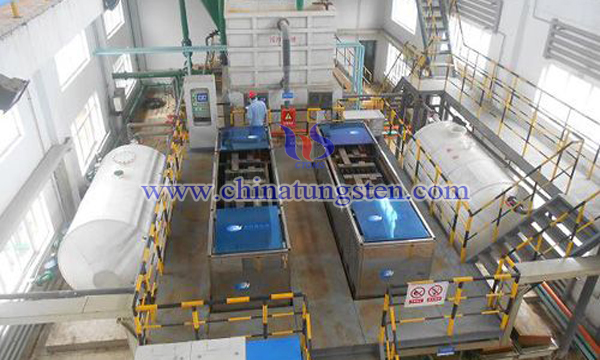Tungsten Smelting Wastewater Simple and Effective Comprehensive Treatment
- Details
- Category: Tungsten Information
- Published on Sunday, 17 June 2018 17:15
China's Tungsten smelting has about 20000000 cubic meters of wastewater every year. Most of the production enterprises have serious problems of ammonia nitrogen, arsenic, phosphorus and fluoride emissions. How to solve the environmental pollution of tungsten smelting industry, protect river water and people's health, and realize the sustainable development of tungsten industry is of great significance.

China mainly uses ammonium ion exchange technology to produce ammonium para tungstate. The wastewater from tungsten smelting production consists of two parts: ammonium partrammonium tungstate crystallization, condensation, recovery of dilute ammonia water and ion exchange wastewater which can not be recycled. The content of ammonia nitrogen in dilute ammonia water is 3000 ~ 4000mg/L, the content of arsenic in the liquid after exchange is 2 ~ 3.5mg/L, the content of phosphorus is 10 ~ 20mg/L, the content of fluorine is 100 ~ 200mg/L, and the waste water of tungsten smelting process is more than the national standard.
The recycling of dilute ammonia water mainly uses sodium hydroxide stripping method to remove ammonia nitrogen, but the method has the disadvantages of high alkali consumption, unthorough removal of ammonia nitrogen and two pollution caused by the direct discharge of low concentration ammonia gas discharged. The after ion exchange solution mainly uses ferrous sulfate and polymerized aluminum iron to precipitate arsenic, and the tungsten is high in arsenic content. The removal effect is poor, and phosphorus and fluoride can not be removed at the same time. Some scholars have proposed a comprehensive recycling scheme for tungsten smelting wastewater, which can be divided into two steps to deal with ammonia nitrogen and arsenic, phosphorus and fluorine. The main contents are as follows:
(1) The ammonia nitrogen removal stage of tungsten smelting wastewater, normal temperature, adding bleach powder, bleach powder and ammonia nitrogen mass ratio 6.9 ~34.7, pH = 4~12, reaction time 10min, stirring speed 600r/min.
(2) In the phase of removal of arsenic, phosphorus and fluorine, the mixture volume ratio of ammonia nitrogen removal solution and ion exchange is 0.1, at normal temperature, the concentration of sodium hydroxide is 2g/L, and the time of mixing reaction is 4.0h. The removal rates of arsenic, phosphorus and fluorine were 28.6%, 61% and 54% respectively.
Compared with the current ammonium and magnesium salt process, the removal rate of ammonia nitrogen is about 20%, the removal rate of arsenic is about 50%, the removal rate of phosphorus is raised by 90%, and the removal rate of fluorine is increased by 36%. The consumption cost of raw and auxiliary materials is reduced by 380 yuan /t APT, and the method is simple and practical.
- Tungsten Manufacturer & Supplier, Chinatungsten Online: www.chinatungsten.com
- Tungsten News & Prices of China Tungsten Industry Association: www.ctia.com.cn
- Molybdenum News & Price: news.molybdenum.com.cn
- Tel.: 86 592 5129696; Fax: 86 592 5129797; Email: sales@chinatungsten.com



 sales@chinatungsten.com
sales@chinatungsten.com